2018-10-18 - Nº 181
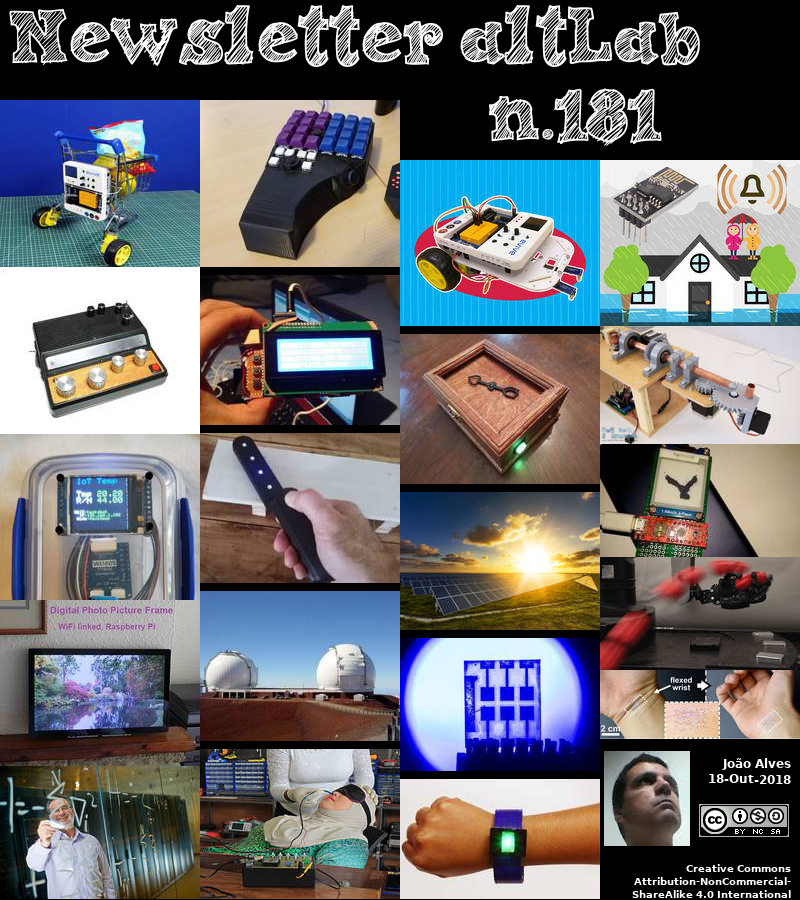
Editorial
Esta é a Newsletter Nº 181 que se apresenta com o mesmo formato que as anteriores. Se gostar da Newsletter partilhe-a!
Todas as Newsletters encontram-se indexadas no link.
Esta Newsletter tem os seguintes tópicos:
Faz hoje anos que nascia, em 1787, Robert Livingston Stevens. Este engenheiro norte-americano e projectista de navios inventou o carril ferroviário T invertido e o espigão de fixação ferroviário. Ele descobriu que os trilhos colocados em barrotes de madeira, com brita ou cascalho por baixo, proporcionavam uma estrada superior a qualquer outra conhecida anteriormente. Ele também adicionou o piloto - objecto em forma de V para desviar obstáculos da linha - à locomotiva, e aumentou o número de rodas motrizes para oito para melhor tracção.
Faz igualmente hoje anos que nascia, em 1799, Christian Friedrich Schönbein. Este Químico germano-suíço descobriu e deu nome ao ozónio (1840) e foi o primeiro a descrever o guncotton (nitro-celulose). Ele notou que o ozónio aparecia durante tempestades e chamou ao ozónio o gás pelo seu cheiro peculiar (ozo é grego para o olfacto). Experiências posteriores mostraram que o envio de uma corrente eléctrica através de oxigénio puro e seco (O2) cria ozónio (O3). A sua descoberta do poderoso explosivo chamado nitrato de celulose, ou arma de algodão, foi o resultado de um acidente de laboratório. Um dia, em 1845, derramou ácido sulfúrico e nítrico e encharcou-o com um avental de algodão. Depois que o avental secou, ele explodiu em chamas - ele tinha criado a celulose nitrada. Ele descobriu que o nitrato de celulose podia ser moldado e tinha algumas propriedades elásticas. Eventualmente foi usado para pólvora sem fumo.
Por fim, faz anos hoje que nascia, em 1902, Pascual Jordan. Este físico alemão no final dos anos 1920 co-fundou (com Max Born e depois Werner Heisenberg) a mecânica quântica usando métodos matriciais, mostrando como a luz poderia ser interpretada como composta de quantum de energia. Mais tarde, (com Wolfgang Pauli e Eugene Wigner), enquanto ainda estava nos seus estágios iniciais de desenvolvimento, ele contribuiu para as mecânicas quânticas de interacções electrão-fotão, agora chamadas de electrodinâmica quântica. Ele também originou (concomitantemente com Robert Dicke) uma teoria da cosmologia que propunha fazer as constantes universais da natureza (como a constante gravitacional universal G), variável ao longo do tempo.
Foi hoje lançado o mais recente sistema da Canonical o Ubuntu 18.10. Este sistema encontra-se focado em ambientes multi-cloud, desenvolvimento de software de Inteligência Artificial, traz um novo tema de ambiente de trabalho comunitário e uma integração mais afinada com os SNAPs. Este sistema usa o GNOME 3.30 e o Kernel Linux 4.18. Outros destaques incluem o suporte VeraCrypt no GNOME Disks, efeitos suaves de visualização e zoom de desktop, suporte para desbloquear o seu PC com impressões digitais, melhor suporte Snap, integração de telefone móvel com GS Connect, assim como suporte para a gestão de dispositivos Thunderbolt no painel de configurações. Na base do sistema foram actualizadas as ferramentas de desenvolvimento que consistem em GNU C Library (Glibc) 2.28, GNU Compiler Collection (GCC) 8.2, OpenSSL 1.1.1, Python 3.6.7 (padrão) e 3.7.1, Boost 1.67, Ruby 2.5.1, Perl 5.26.2, PHP 7.2.10, Golang 1.10.4, Rust 1.28 e OpenJDK 11.
Na Newsletter desta semana apresentamos diversos projetos de maker. É apresentada a revista Hackspace Nº12 e o Volume 4 do "The Official Raspberry PI Projects Book".
 João Alves ([email protected])
João Alves ([email protected])
O conteúdo da Newsletter encontra-se sob a licença  Creative Commons Attribution-NonCommercial-ShareAlike 4.0 International License.
Creative Commons Attribution-NonCommercial-ShareAlike 4.0 International License.
Novidades da Semana

Ubuntu 18.10:Multi-cloud,new desktop theme & enhanced snap integration
"Canonical today announced the release of Ubuntu 18.10, focused on multi-cloud deployments, AI software development, a new community desktop theme and richer snap desktop integration. “Ubuntu is now the world’s reference platform for AI engineering and analytics” said Mark Shuttleworth, CEO of Canonical. “We accelerate developer productivity and help enterprises operate at speed and at scale, across multiple clouds and diverse edge appliances.” This year, the financial services industry has engaged significantly with Canonical and Ubuntu for infrastructure efficiency on-premise and to accelerate their move to the cloud. The push for machine learning analytics and of fintech efforts around blockchain, distributed ledger applications and cryptocurrencies are current drivers of Ubuntu investments and deployments. Optimised for multi-cloud computing Ubuntu Server 18.10 images are available on all major public clouds, including minimal images popular for container workloads with a small footprint and fast boot time. For private clouds, Ubuntu 18.10 ships with OpenStack Rocky for AI and NFV hardware acceleration and Ceph Mimic to reduce storage overhead." [...]
Outras Notícias
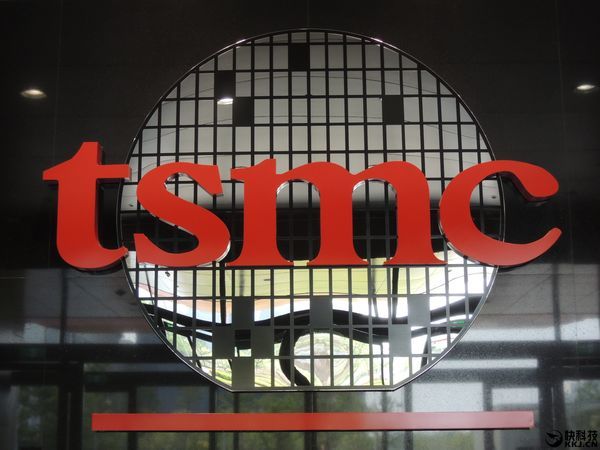
TSMC to Start 5nm Production in April
"TSMC taped out its first chip in a process making limited use of extreme ultraviolet lithography and will start risk production in April on a 5-nm node with full EUV. Separately, the foundry forged partnerships with four partners to support online services for back-end chip design. The foundry’s update showed that area and power gains continue in its leading-edge nodes, but chip speeds are no longer advancing at their historic rate. To compensate, TSMC gave an update on a half-dozen packaging techniques that it is developing to speed connections between chips. Backers say that cloud-based services will shorten the time and extend the reach of chip design tools, helping expand a semiconductor industry facing the slowdown of Moore’s Law. However, they note that cloud design is still in an early phase that typically requires setting up and optimizing custom sites." [...]
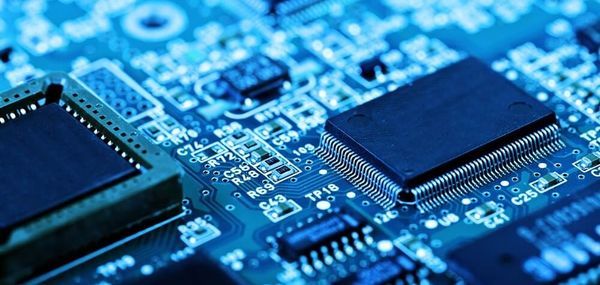
Introducing Arm Mbed Linux OS
"I'm excited to announce today that Arm is expanding the Mbed family with a brand-new operating system, Arm Mbed Linux OS. One of the most rewarding aspects of product management is when you solve pervasive problems that you've experienced first-hand. In my case, I've been creating embedded products for around 25 years. Today many of these products would be described as IoT. Throughout this time, some common themes and challenges have emerged and recurred. Products were usually left unattended." [...]
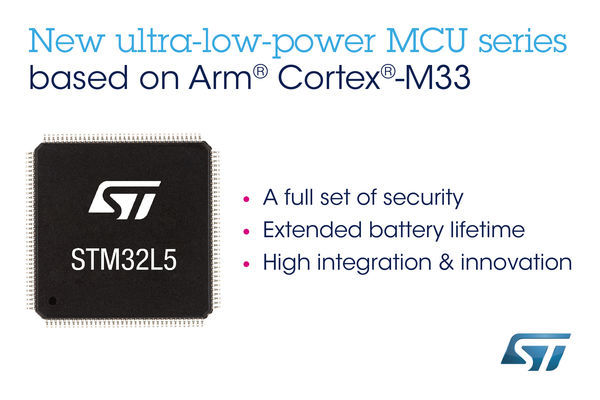
STMicroelectronics Introduces STM32L5 Ultra-Low-Power Microcontrollers for a More Secured IoT
"STMicroelectronics, a global semiconductor leader serving customers across the spectrum of electronics applications, is bringing sophisticated cyber-protection to power-conscious connected devices with the new STM32L5 microcontroller (MCU) series featuring the Arm® Cortex® -M33 core. Building on the Cortex-M33, which boosts protection for small devices by integrating Arm’s TrustZone® hardware-based security, ST’s STM32L5-series MCUs add further enhancements including flexible software isolation, secure boot, key storage, and hardware cryptographic accelerators. They also provide rich functionality, high performance, and long run-times powered by coin cells or energy harvesting. Consuming as little as 33nA in shutdown mode and achieving 402 ULPMark-CP in the EEMBC[1] ULPBench, the new MCU series builds on the Company’s expertise in low-power techniques such as adaptive voltage scaling, real-time acceleration, power gating, and multiple reduced-power operating modes proven in previous STM32L series. “The STM32L5 series with TrustZone and additional custom protection features considerably strengthens and hardens cyber-protection for small IoT devices,” said Ricardo De Sa Earp, Microcontroller Division General Manager, STMicroelectronics. “Also featuring our unique energy-saving technologies, rich connectivity, and smart digital and analog peripherals, these devices will be the first choice to host cutting-edge connected applications.” With extensive integrated digital and analog peripherals, and consumer and industrial interfaces such as CAN FD[2], USB Type-C™, and USB Power Delivery, STM32L5 MCUs provide an ideal platform for products such as industrial sensors or controls, home-automation devices, smart meters, fitness trackers, smart watches, medical pumps or meters, and many others." [...]
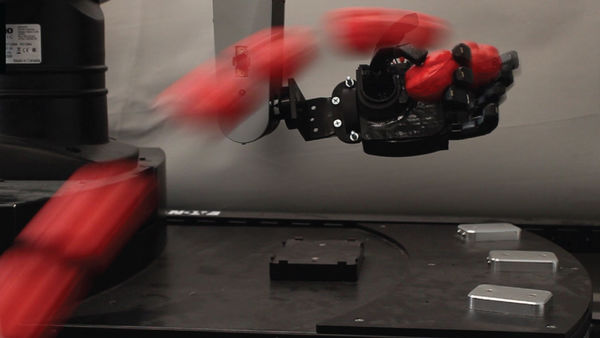
This 3D-printed prosthetic hand combines speed and strength with simplicity
"Prosthetic limbs have come a long way from the heavy, solid hands and legs of yesteryear, but it’s still difficult to pack a range of motion into them without complex or bulky machinery. But new research out of Cornell uses a cleverly designed 3D-printed mechanism to achieve speed and strength with simple construction — and it costs a lot less, too. “Developing prosthetic limbs requires designers to make difficult trade-offs among size, weight, force, speed, and cost of the actuation system,” the researchers say in their paper. For example, they point out, state of the art mechanical prosthetic hands can cost well over $10,000, with the high-end motors inside alone costing hundreds each. Cheaper hands use cheaper components, of course, which might mean that the hand can grip hard but not quickly, or vice versa. This is partly because a mechanical hand needs to be able to adjust the force it’s applying very quickly on the fly, and this usually involves some kind of variable transmission or dynamic gear ratio." [...]

Intel Artificial Intelligence and Rolls-Royce Push Full Steam ahead on Autonomous Shipping
"Rolls-Royce* builds shipping systems that are sophisticated and intelligent – and eventually it will add fully autonomous to that portfolio – as it makes commercial shipping safer and more efficient. It’s doing so using artificial intelligence (AI) powered by Intel® Xeon® Scalable processors and Intel® 3D NAND SSDs for storage. How It Works: Ships have dedicated Intel Xeon Scalable processor-based servers on board, turning them into cutting-edge floating data centers with heavy computation and AI inference capabilities. Rolls-Royce’s Intelligent Awareness System (IA) uses AI-powered sensor fusion and decision-making by processing data from lidar, radar, thermal cameras, HD cameras, satellite data and weather forecasts. This data allows vessels to become aware of their surroundings, improving safety by detecting objects several kilometers away, even in busy ports. This is especially important when operating at night, in adverse weather conditions or in congested waterways." [...]
Ciência e Tecnologia

Researchers solve mystery at the centre of the Milky Way
"Astronomers from Lund University in Sweden have now found the explanation to a recent mystery at the centre of the Milky Way galaxy: the high levels of scandium discovered last spring near the galaxy’s giant black hole were in fact an optical illusion. Last spring, researchers published a study about the apparent presence of astonishing and dramatically high levels of three different elements in red giant stars, located less than three light years away from the big black hole at the centre of our galaxy. Various possible explanations were presented, for example that the high levels were a result of earlier stars being disrupted as they fall into the black hole, or a result of debris from the collisions of neutron stars. Now another group of astronomers from Lund University among others, in collaboration with UCLA in California, have found an explanation for the high levels of scandium, vanadium and yttrium. They argue that the so-called spectral lines presented last spring were actually an optical illusion. Spectral lines are used to find out which elements a star contains - by using its own light." [...]

Graphene shows unique potential to exceed bandwidth demands of future telecommunications
"Graphene enables ultra-wide bandwidth communications coupled with low power consumption, with potential to surpass the needs of 5G, IoT and Industry 4.0. Researchers within the Graphene Flagship project, one of the biggest research initiatives of the European Commission, showed that integrated graphene-based photonic devices offer a unique solution for the next generation of optical communications. Researchers in the initiative have demonstrated how properties of graphene enable ultra-wide bandwidth communications coupled with low power consumption to radically change the way data is transmitted across the optical communications systems. This could make graphene-integrated devices the key ingredient in the evolution of 5G, the Internet-of-Things (IoT), and Industry 4.0. The findings were published in Nature Reviews Materials and highlighted on the cover. "As conventional semiconductor technologies are approaching their physical limitations we need to explore entirely new technologies to realise our most ambitious visions of a future networked global society," explains Wolfgang Templ, Department Head of Transceiver Research at Nokia Bell Labs in Germany, which is a Graphene Flagship partner." [...]

PaintCopter: An Autonomous UAV for Spray Painting on 3D Surfaces
"This paper describes a system for autonomous spray painting using a UAV, suitable for industrial applications. The work is motivated by the potential for such a system to achieve accurate and fast painting results. The PaintCopter is a quadrotor that has been custom fitted with an arm plus a spray gun on a pan-tilt mechanism. To enable long deployment times for industrial painting tasks, power and paint are delivered by lines from an external unit. The ability to paint planar surfaces such as walls in single color is a basic requirement for a spray painting system. But this work addresses more sophisticated operation that subsumes the basic task, including painting on 3D structure, and painting of a desired texture appearance." [...]

Pentacene patterns prove crucial for solar power
"Renewable solar power can be harnessed using solar cells, which are made of materials called semiconductors. In a solar cell, electrons are generated when photons, or packets of light, are absorbed by semiconductors and released as high energy electrons. However, in some materials, one photon can generate two excited electrons – a highly unusual phenomenon known as singlet fission. In this case not all the electrons are able to escape the semiconductor and to be used as electricity. Now, researchers based at Imperial College London and UCL’s joint London Centre for Nanotechnology have identified the best pattern for how molecules of the widely used semiconductor, pentacene, should be arranged to release the most electrons possible during singlet fission. The findings are published in Nature Communications." [...]
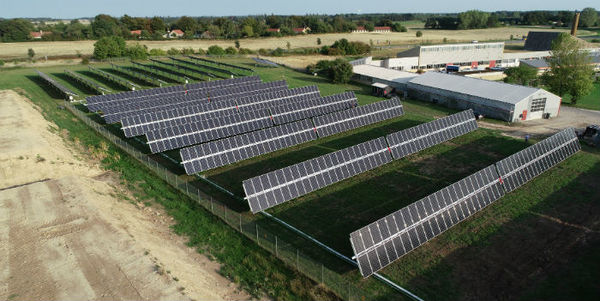
DTU optimizes solar cell technology
"DTU researchers will test a new type of solar cell technology that harvests energy from two sides. The results are expected to contribute to Denmark becoming the leader in the field in the solar industry. The Danish energy company European Energy has just established a test centre at DTU Risø Campus. Here, DTU researchers will now begin studying how to create optimal conditions for the so-called bifacial solar cells, which, in contrast to the traditional monofacial solar cells harvest solar energy from two sides. “Bifacial solar cells are a technology which in the solar industry are viewed as promising for achieving a greater effect without increasing installation costs, which could help make solar energy more competitive,” explains researcher and project manager Peter Poulsen from DTU Fotonik, who has been involved from the very start when the European Energy suggested a collaboration. Will increase energy harvest by 50 per cent Not only are the solar cells harvesting solar energy from both sides, they are also placed on the tracker systems following the Sun from sunrise in the East to sunset in the West." [...]

Quantum computers tackle big data with machine learning
"Purdue researchers develop algorithms for faster, better data analysis Every two seconds, sensors measuring the United States’ electrical grid collect 3 petabytes of data – the equivalent of 3 million gigabytes. Data analysis on that scale is a challenge when crucial information is stored in an inaccessible database. But researchers at Purdue University are working on a solution, combining quantum algorithms with classical computing on small-scale quantum computers to speed up database accessibility. They are using data from the U.S. Department of Energy National Labs’ sensors, called phasor measurement units, that collect information on the electrical power grid about voltages, currents and power generation. Because these values can vary, keeping the power grid stable involves continuously monitoring the sensors. Sabre Kais, a professor of chemical physics and principal investigator, will lead the effort to develop new quantum algorithms for computing the extensive data generated by the electrical grid." [...]
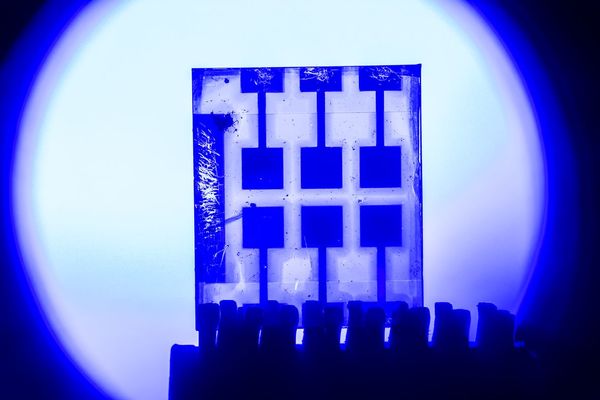
Perovskites - materials of the future in optical communication
"Researchers at the universities in Linköping and Shenzhen have shown how an inorganic perovskite can be made into a cheap and efficient photodetector that transfers both text and music. “It’s a promising material for future rapid optical communication”, says LiU researcher Feng Gao. “Perovskites of inorganic materials have a huge potential to influence the development of optical communication. These materials have rapid response times, are simple to manufacture, and are extremely stable.” So says Feng Gao, senior lecturer at LiU who, together with colleagues who include Chunxiong Bao, postdoc at LiU, and scientists at Shenzhen University, has published the results in the prestigious journal Advanced Materials. All optical communication requires rapid and reliable photodetectors – materials that capture a light signal and convert it into an electrical signal. Current optical communication systems use photodetectors made from materials such as silicon and indium gallium arsenide." [...]
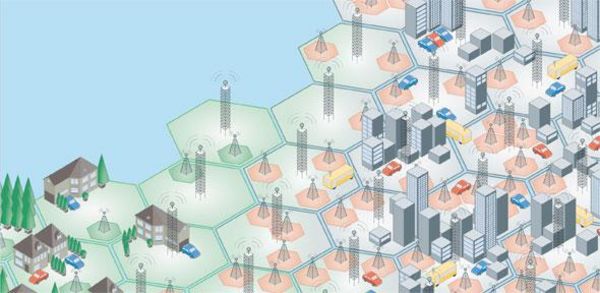
Graphene may exceed bandwidth demands of future telecommunications
"Researchers from the Cambridge Graphene Centre, together with industrial and academic collaborators within the European Graphene Flagship project, showed that integrated graphene-based photonic devices offer a solution for the next generation of optical communications. The researchers have demonstrated how properties of graphene – a two-dimensional form of carbon - enable ultra-wide bandwidth communications and low power consumption to radically change the way data is transmitted across the optical communications systems. This could make graphene-integrated devices the key ingredient in the evolution of 5G, the Internet-of-Things (IoT), and Industry 4.0. The findings are published in Nature Reviews Materials. As conventional semiconductor technologies approach their physical limitations, researchers need to explore new technologies to realise the most ambitious visions of a future networked global society. Graphene promises a significant step forward in performance for the key components of telecommunications and data communications." [...]
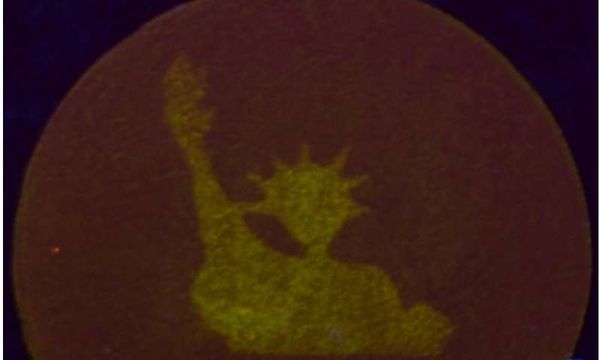
Versatile molecular system extends the promise of light-activated switches
"New chemical structure proves useful in liquid and solid state Light-activated switches are too small to be seen by the naked eye, but the molecular systems are hard at work in research related to drug design, adaptive materials and data storage. To unlock the promise of new generations of medical therapies and memory systems, researchers must first overcome the drawbacks of the microscopic devices that can be difficult to produce and lack versatility. Researchers at Dartmouth College have developed a new molecular switch based on the hydrazone functional group that combines the most important properties of the current class of light-activated switches and solves many of the problems associated with them. The newly-developed molecule is easy to make, simple to work with, shows “on-off” fluorescence emission toggling, and can be used to write, read and erase information in both the liquid and solid state. Looking into the future, switches like these may potentially be used for the development of sophisticated photomedications that deliver drugs with cellular-level precision. In years to come, hydrazone switches might also lead to the development of high-density memory devices with the volume of a speck of a dust." [...]
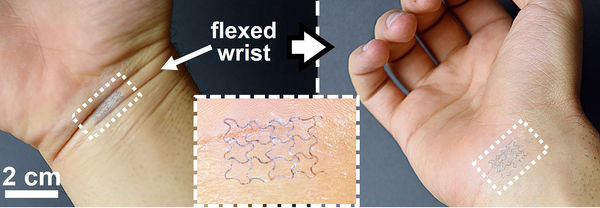
Simple stickers may save lives of heart patients, athletes and lower medical costs for families
"Heart surgery can be traumatic for patients. Having to continuously monitor your status without a doctor when you are back home can be even scarier. Imagine being able to do that with a simple sticker applied to your body. Purdue University researchers have advanced a sticker solution moving it several steps closer to reality. The research was recently published in ACS Advanced Materials and Interfaces. A YouTube video is available at http://bit.ly/EPED-Purdue." [...]
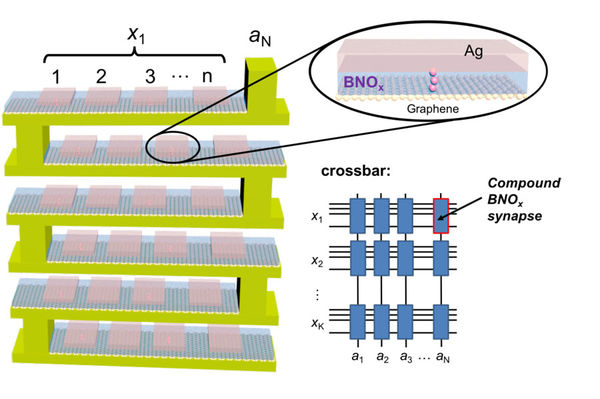
New Memristor Boosts Accuracy and Efficiency For Neural Networks on an Atomic Scale
"A new parallel processing approach for building resistance-based artificial synapses promises to ramp up efficiency and accuracy by making memristors as thin as a single atom. From the Journal: Journal of Applied Physics WASHINGTON, D.C., October 16, 2018 -- Just like their biological counterparts, hardware that mimics the neural circuitry of the brain requires building blocks that can adjust how they synapse, with some connections strengthening at the expense of others. One such approach, called memristors, uses current resistance to store this information. New work looks to overcome reliability issues in these devices by scaling memristors to the atomic level. A group of researchers demonstrated a new type of compound synapse that can achieve synaptic weight programming and conduct vector-matrix multiplication with significant advances over the current state of the art. Publishing its work in the Journal of Applied Physics, from AIP Publishing, the group’s compound synapse is constructed with atomically thin boron nitride memristors running in parallel to ensure efficiency and accuracy." [...]
Goodbye, silicon?
"Scientists at the Max Planck Institute for Polymer Research (MPI-P) in Mainz (Germany) together with scientists from Dresden, Leipzig, Sofia (Bulgaria) and Madrid (Spain) have now developed and characterized a novel, metal-organic material which displays electrical properties mimicking those of highly crystalline silicon. The material which can easily be fabricated at room temperature could serve as a replacement for expensive conventional inorganic materials used in optoelectronics. Silicon, a so called semiconductor, is currently widely employed for the development of components such as solar cells, LEDs or computer chips. High purity silicon, a highly ordered material which is expensive to produce, is required to develop such applications. This is due to the fact that the electrical properties of a semiconductor (as silicon) are strongly affected by disorder. The scientists around group leader Enrique Cánovas (MPI-P, Department of Prof. Dr. Mischa Bonn) have now developed a novel low cost metal-organic framework (MOF), which has similar electrical properties." [...]

A step toward personalized, automated smart homes
"System that automatically identifies people moving around indoors could enable self-adjusting homes. Developing automated systems that track occupants and self-adapt to their preferences is a major next step for the future of smart homes. When you walk into a room, for instance, a system could set to your preferred temperature. Or when you sit on the couch, a system could instantly flick the television to your favorite channel. But enabling a home system to recognize occupants as they move around the house is a more complex problem. Recently, systems have been built that localize humans by measuring the reflections of wireless signals off their bodies." [...]
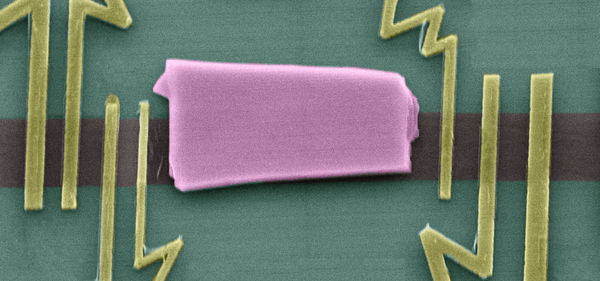
Exploring new spintronics device functionalities in graphene heterostructures
"Graphene Flagship researchers have shown in a paper published in Science Advances how heterostructures built from graphene and topological insulators have strong, proximity induced spin-orbit coupling which can form the basis of novel information processing technologies. Spin-orbit coupling is at the heart of spintronics. Graphene’s spin-orbit coupling and high electron mobility make it appealing for long spin coherence length at room temperature. Graphene Flagship researchers from Chalmers University of Technology (Sweden), Catalan Institute of Nanoscience and Nanotechnology - ICN2 (Spain), Universitat Autònoma de Barcelona (Spain) and ICREA Institució Catalana de Recerca i Estudis Avançats (Spain) showed a strong tunability and suppression of the spin signal and spin lifetime in heterostructures formed by graphene and topological insulators. This can lead to new graphene spintronic applications, ranging from novel circuits to new non-volatile memories and information processing technologies. “The advantage of using heterostructures built from two Dirac materials is that, graphene in proximity with topological insulators still supports spin transport, and concurrently acquires a strong spin–orbit coupling,” said Associate Professor Saroj Prasad Dash, from Chalmers University of Technology." [...]
Controlling organic semiconductor band gaps by electron-acceptor fluorination
"Organic semiconductor materials have the potential to be used in innovative applications such as transparent and flexible devices, and their low cost makes their potential use particularly attractive. The properties of organic semiconductor materials can be tuned by controlling their structure at the molecular level through parts of the structure known as electron-accepting units. A group of researchers centered at Osaka University has specifically tailored an electron-accepting unit that was then successfully used in an organic semiconductor applied in solar cell device that showed high photovoltaic performance. Their findings were published in NPG Asia Materials. “Electron-accepting units are important elements of organic semiconductors,” study corresponding author Yoshio Aso says. “Through the controlled addition of electronegative fluorine groups to a widely used electron-accepting material, we were able to show precise control of the energy levels within the resulting semiconductor." [...]
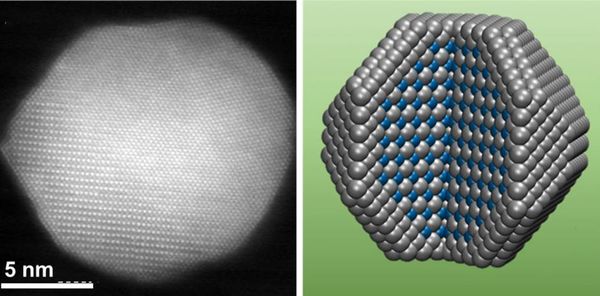
New, durable catalyst for key fuel cell reaction may prove useful in eco-friendly vehicles
"The new catalyst, developed by Brown University researchers, exceeds Department of Energy targets for performing the oxygen reduction reaction, a key step in generating an electric current in a hydrogen fuel cell. One factor holding back the widespread use of eco-friendly hydrogen fuel cells in cars, trucks and other vehicles is the cost of the platinum catalysts that make the cells work. One approach to using less precious platinum is to combine it with other cheaper metals, but those alloy catalysts tend to degrade quickly in fuel cell conditions. Now, researchers from Brown University have developed a new alloy catalyst that both reduces platinum use and holds up well in fuel cell testing. The catalyst, made from alloying platinum with cobalt in nanoparticles, was shown to beat U.S. Department of Energy (DOE) targets for the year 2020 in both reactivity and durability, according to tests described in the journal Joule. "The durability of alloy catalysts is a big issue in the field," said Junrui Li, a graduate student in chemistry at Brown and the study's lead author." [...]
Boron nitride semiconductor could convert power more efficiently than silicon wafer technologies
"Boron nitride is a semiconductor that could be used to make electrical equipment able to convert power more efficiently than silicon wafer technologies, up to three to 4% more efficiently than what is possible today. To achieve this higher energy efficiency, a cubic boron nitride (c-BN) single-crystal wafer is needed. Such a wafer could also be used for more efficient high-voltage power electronics due to c-BN’s hardiness. Cubic boron nitride and boron carbide are two of the hardest known materials along with diamond. C-BN is used to drill, cut and ground tough materials into shape. However, the synthesis of c-BN occurs under high-pressure, high-temperature conditions and uses catalysts such as lithium or barium nitride." [...]
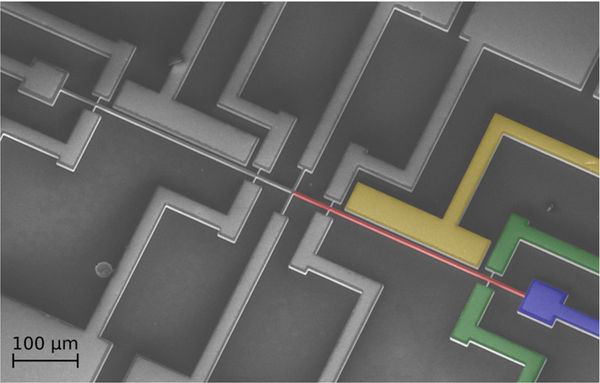
New Reservoir Computer Marks First-Ever Microelectromechanical Neural Network Application
"Researchers used oscillations from a microscopic beam of silicon to enable the nonlinear dynamics that allow neural networks to complete tasks ranging from processing image patterns to recognizing words. From the Journal: Journal of Applied Physics WASHINGTON, D.C., October 16, 2018 -- As artificial intelligence has become increasingly sophisticated, it has inspired renewed efforts to develop computers whose physical architecture mimics the human brain. One approach, called reservoir computing, allows hardware devices to achieve the higher-dimension calculations required by emerging artificial intelligence. One new device highlights the potential of extremely small mechanical systems to achieve these calculations. A group of researchers at the Université de Sherbrooke in Québec, Canada, reports the construction of the first reservoir computing device built with a microelectromechanical system (MEMS). Published in the Journal of Applied Physics, from AIP Publishing, the neural network exploits the nonlinear dynamics of a microscale silicon beam to perform its calculations." [...]

First proof of quantum computer advantage
"Scientists develop new quantum circuit Quantum computers promise to revolutionize the future of computing. A scientist from the Technical University of Munich (TUM) together with his colleagues from the University of Waterloo and from IBM have now demonstrated for the first time that quantum computers do indeed offer advantages over conventional computers. For many years, quantum computers were not much more than an idea. Today, companies, governments and intelligence agencies are investing in the development of quantum technology. Robert König, professor for the theory of complex quantum systems at the TUM, in collaboration with David Gosset from the Institute for Quantum Computing at the University of Waterloo and Sergey Bravyi from IBM, has now placed a cornerstone in this promising field. WHY SHOULD QUANTUM COMPUTERS BE FASTER?" [...]
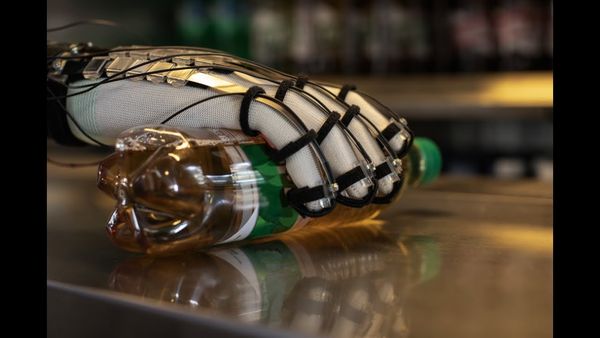
Ultra-light gloves let users "touch" virtual objects
"Engineers and software developers around the world are seeking to create technology that lets users touch, grasp and manipulate virtual objects, while feeling like they are actually touching something in the real world. Scientists at EPFL and ETH Zurich have just made a major step toward this goal with their new haptic glove, which is not only lightweight – under 8 grams per finger – but also provides feedback that is extremely realistic. The glove is able to generate up to 40 Newtons of holding force on each finger with just 200 Volts and only a few milliWatts of power. It also has the potential to run on a very small battery. That, together with the glove’s low form factor (only 2 mm thick), translates into an unprecedented level of precision and freedom of movement. “We wanted to develop a lightweight device that – unlike existing virtual-reality gloves – doesn’t require a bulky exoskeleton, pumps or very thick cables,” says Herbert Shea, head of EPFL’s Soft Transducers Laboratory (LMTS)." [...]

These Researchers Want to Send Smells Over the Internet
"Electrical stimulation of cells in the nasal passages produces sweet fragrances and chemical odors Imagine a virtual reality movie about the Civil War where you can smell the smoke from the soldiers’ rifles. Or an online dating site where the profiles are scented with perfume or cologne. Or an augmented reality app that lets you point your phone at a restaurant menu and sample the aroma of each dish. The researchers who are working on “digital smell” are still a very long way from such applications—in part because their technology’s form factor leaves something to be desired. Right now, catching a whiff of the future means sticking a cable up your nose, so electrodes can make contact with neurons deep in the nasal passages. But they’ve got some ideas for improvements." [...]

Electrical properties of dendrites help explain our brain's unique computing power
"Neurons in human and rat brains carry electrical signals in different ways, scientists find. Neurons in the human brain receive electrical signals from thousands of other cells, and long neural extensions called dendrites play a critical role in incorporating all of that information so the cells can respond appropriately. Using hard-to-obtain samples of human brain tissue, MIT neuroscientists have now discovered that human dendrites have different electrical properties from those of other species. Their studies reveal that electrical signals weaken more as they flow along human dendrites, resulting in a higher degree of electrical compartmentalization, meaning that small sections of dendrites can behave independently from the rest of the neuron. These differences may contribute to the enhanced computing power of the human brain, the researchers say. “It’s not just that humans are smart because we have more neurons and a larger cortex." [...]
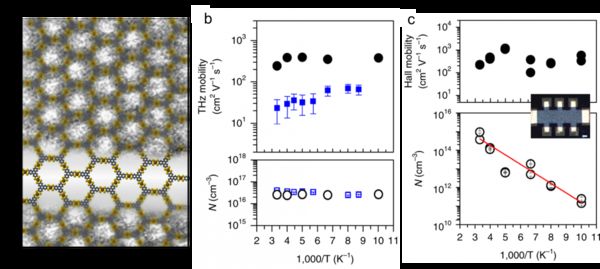
MOFtronics: 2D Metal-Organic Frameworks Are Ready for Electronics
"A group of scientists has observed for the first time band-like electron transport in a conjugated two-dimensional (2D) metal-organic framework film (Nature Materials, "High-mobility band-like charge transport in a semiconducting two-dimensional metal–organic framework"). This semiconducting behavior, together with its cost-effective production, opens the path for employing metal-organic frameworks as electroactive materials in electronic devices. The 21st century has seen a reinvention of how modern electronics impact our daily lives. Inorganic semiconductors as silicon, germanium or gallium arsenide are at the core of modern electronics; they are currently widely employed in e.g. computer chips, LEDs and solar cells. Inorganic semiconductors are highly pure, crystalline and hence ordered materials, these features make them good conductors of electricity under the application of an external bias (e.g." [...]
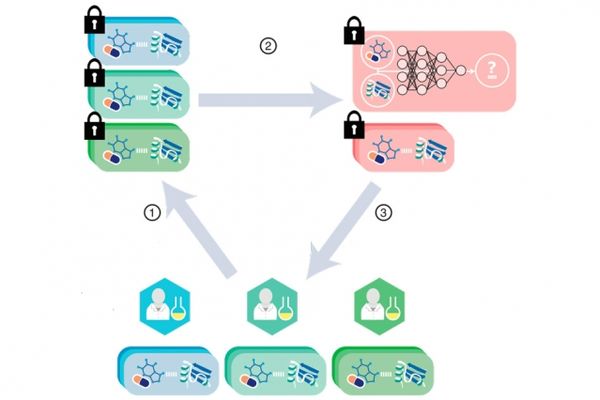
Cryptographic protocol enables greater collaboration in drug discovery
"Neural network that securely finds potential drugs could encourage large-scale pooling of sensitive data. MIT researchers have developed a cryptographic system that could help neural networks identify promising drug candidates in massive pharmacological datasets, while keeping the data private. Secure computation done at such a massive scale could enable broad pooling of sensitive pharmacological data for predictive drug discovery. Datasets of drug-target interactions (DTI), which show whether candidate compounds act on target proteins, are critical in helping researchers develop new medications. Models can be trained to crunch datasets of known DTIs and then, using that information, find novel drug candidates. In recent years, pharmaceutical firms, universities, and other entities have become open to pooling pharmacological data into larger databases that can greatly improve training of these models." [...]

3D-printed lithium-ion batteries
"Electric vehicles and most electronic devices, such as cell phones and laptop computers, are powered by lithium-ion batteries. Until now, manufacturers have had to design their devices around the size and shape of commercially available batteries. But researchers have developed a new method to 3D print lithium-ion batteries in virtually any shape. They report their results in ACS Applied Energy Materials. Most lithium-ion batteries on the market come in cylindrical or rectangular shapes. Therefore, when a manufacturer is designing a product — such as a cell phone — they must dedicate a certain size and shape to the battery, which could waste space and limit design options." [...]
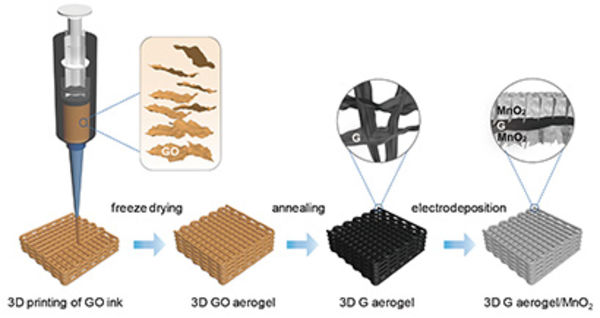
3D-printed supercapacitor electrode breaks records in lab tests
"Advances in supercapacitor technology could lead to wider use of fast-charging energy storage devices and novel designs for electronic gadgets Scientists at UC Santa Cruz and Lawrence Livermore National Laboratory (LLNL) have reported unprecedented performance results for a supercapacitor electrode. The researchers fabricated electrodes using a printable graphene aerogel to build a porous three-dimensional scaffold loaded with pseudocapacitive material. In laboratory tests, the novel electrodes achieved the highest areal capacitance (electric charge stored per unit of electrode surface area) ever reported for a supercapacitor, said Yat Li, professor of chemistry and biochemistry at UC Santa Cruz. Li and his collaborators reported their findings in a paper published October 18 in Joule. As energy storage devices, supercapacitors have the advantages of charging very rapidly (in seconds to minutes) and retaining their storage capacity through tens of thousands of charge cycles. They are used for regenerative braking systems in electric vehicles and other applications." [...]
Documentação
A documentação é parte essencial do processo de aprendizagem e a Internet além de artigos interessantes de explorar também tem alguma documentação em formato PDF interessante de ler. Todos os links aqui apresentados são para conteúdo disponibilizado livremente pelo editor do livro.

HackSpace magazine #12
"Five … Four … Three … Two … One. This month we build our own rocket, and you should too. It's easy to get started and one of the most exciting ways to exercise your maker skills. Oh, and did we mention that there's plenty of speed and flames? AmieDD chats about body hacking Electronics101: Diodes Testing cheap multimeters Lasercut your own rubber stamps" [...]

The Official Raspberry PI Projects Book Volume 4
"The Raspberry Pi is loved the world over by educators and makers thanks to it’s tiny size and endless possibilities. We’ve managed to stuff the fourth edition of the official Raspberry Pi Projects book with another 200 pages of inspiring projects, practical tutorials, and definitive reviews so you can find out why people like it so much. Get involved with the amazing and very active Raspberry Pi community Be inspired by incredible projects made by other people Learn how to make with your Raspberry Pi with our tutorials Find out about the top kits and accessories for your Pi projects And much, much more! " [...]
Projetos Maker
Diversos Projetos interessantes.
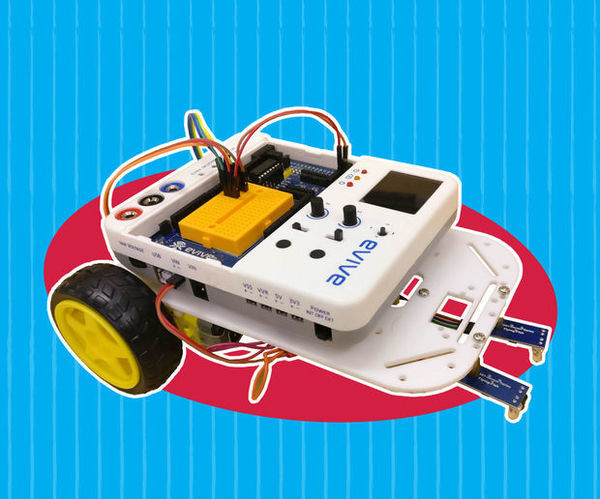
Line Following Robot
"It may not know who you are. But it will look for you and it will find you. And nothing that comes in its way will be spared by it. It is none other than the determined and precise Line Following Robot! Enough of the filmy stuff. Whos all excited to make one with us?" [...]

Autostat : a Remote Thermostat
"The question you are probably asking is "why are you making another remote thermostat?" The answer to that question is, I had to, and the market smart thermostats are too expensive. Fair warning, this is "proof-of-concept" build that would require a few extra outputs to actually control your thermostat, but the core is in place and can be modified depending on your specific circumstance. Also, this is still a work in progress, so expect a few updates and changes (especially to the Matlab code) To get started I want to warn you, this requires three programs (one of them is pretty expensive), quite a few libraries and support packages for the programs, and you need to have them all speak to each other. Its a headache. With that warning out of the way lets get started with the materials." [...]
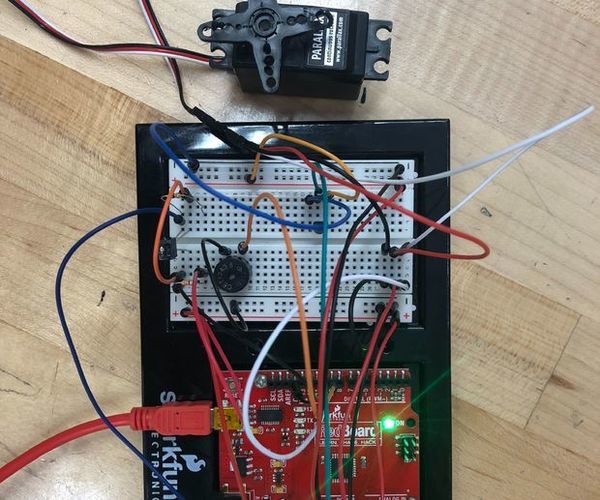
EF 230: Home System 3000 Instructable
"The Home System 3000 is a device that uses an Arduino, a temperature sensor, a piezo buzzer, an optical detector/phototransistor, and a servo to display ways to improve home energy efficiency. " [...]
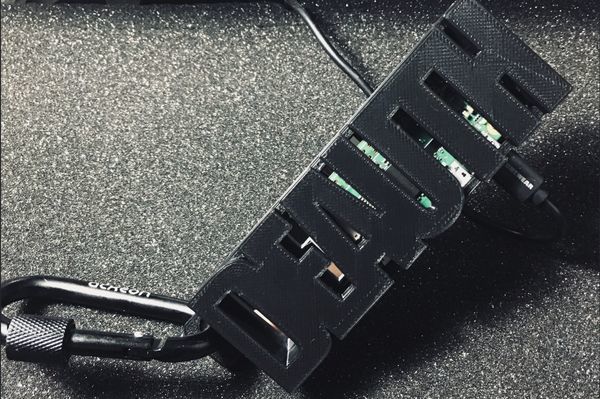
Project Pita: Build A Mini Mass Deauther Using Bettercap And A Raspberry Pi Zero W
"A few days ago I started playing with some idea I had from a few weeks already, using a Raspberry Pi Zero W to make a mini WiFi deauthenticator: something in my pocket that periodically jumps on all the channels in the WiFi spectrum, collects information about the nearby access points and their connected clients and then sends a deauthentication packet to each one of them, resulting in some sort of WiFi jammer on the 802.11 level. As an interesting “side effect” of this jammer (the initial intent was purely for the lulz) is that the more it deauths, the higher the changes to also sniff WPA2 handshakes. Thanks to the awesome work of the Kali and Nexmon communities in packaging the nexmon drivers and utilities and to the recent changes we released in bettercap, this was very easy to setup and to script and given the interest the tweet had I thought to share this writeup :)" [...]

Improved Personal Compass
"I found the personal compass project at Instructables.com quite interesting. Basically, a personal compass works like a regular compass, but instead of pointing to magnetic north, it points to a particular location of personal interest. Maybe it is pointing to the place where you were married, perhaps where your childhood home is. All this compass magic is done using an Arduino with a compass (magnetometer) sensor, GPS module and a servo motor to point the way. However, there were a couple of things I didn’t like about the original project: Extra gears were needed to increase the servo’s sweep to 360 degrees Location was hard coded into the code The extra gears complicated the build and it still had to “rewind” itself when it reached its 360 degree limit, so I decided to use a continuous servo with feedback. This allowed for full 360 degree rotation and beyond of the compass needle." [...]
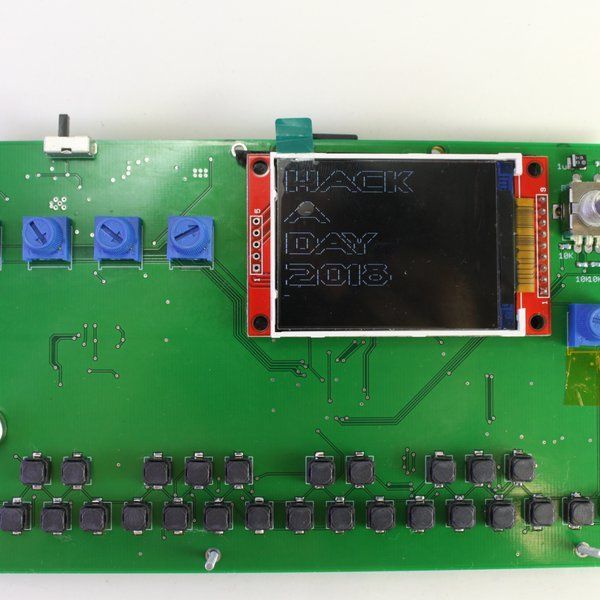
Puredata Portable Synth
"Buildroot-based puredata synth, using the nanopi neo core and a CM6206 USB soundcard DESCRIPTION I saw the Organelle, and I really wanted one. They released their software as open source, but not their hardware. I decided I would just figure out what they were doing and recreate it on a quad-core Allwinner H3 instead of their single core implementation. DETAILS I decided there needed to be an open source hardware project along the pocket operator-organelle-OP1 spectrum. Single board computers are powerful enough to manage. This is the beginning of creating a series of open source hardware projects with a musical embedded linux focus." [...]
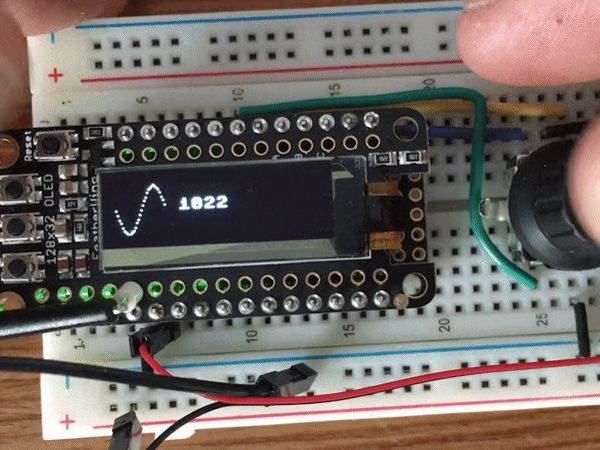
Feather Waveform Generator in CircuitPython
"In this guide we'll take a few simple parts, add some not quite as simple code, and build an adjustable waveform generator (aka frequency generator). Using a rotary encoder push-switch, we'll select one of multiple waveforms, and using the rotation along with the three buttons on the OLED FeatherWing we'll adjust the frequency. We have great guides on the Feather M0 Express and Feather M4 Express as well as the OLED Featherwing to get you up to speed on this hardware. A small speaker is useful to listen to the signal as a functional test. There's a nice one listed below but there are others; any 8 ohm speaker will work. The signal isn't very strong, so stick with a small one." [...]

AM Radio Transmitter
"AM Radio transmissions are based on a carrier signal which is modulated by the audio signal. It’s a very basic principle but prone to noise from the environment. Using the ESP32 it is really simple to generate an analog signal using the built-in DACs. With the provided code here just a wire as an antenna has to be connected to the pin 25 of the ESP32. The transmission will end up on the AM frequency ~835kHz. " [...]
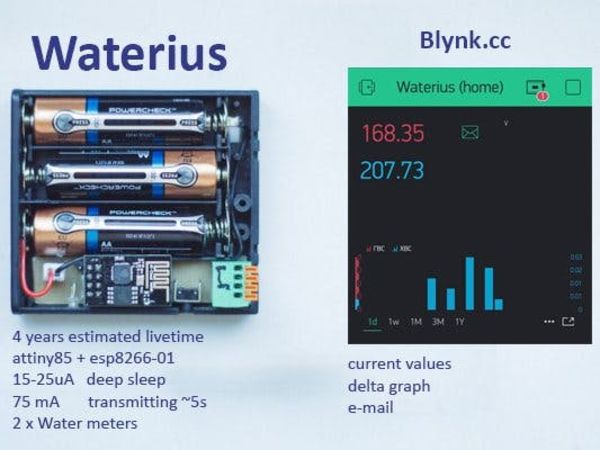
Waterius
"Get water meter data sent to your mobile phone using Wi-Fi. Made with ATtiny85 + ESP8266-01 + Blynk.cc and AA batteries. Story Goal Transfer water meter data to mobile phone using home Wi-Fi. Use AA batteries for power. Waterius can sends: current values everyday delta values (per day) voltage e-mail by Blynk (title and message template) data to your TCP server Values saved in ATtiny EEPROM cycle buffer (~2 millions cycles). "Software ESD protection"." [...]

Tiny Function Plotter
"This project describes a simple routine for plotting a function on a 128x64 I2C OLED graphics display. Unlike most Arduino graphics libraries this routine doesn't require a RAM buffer, and so will work on any processor down to an ATtiny85: The routine will work on monochrome 128x64 I2C OLED displays based on either the SSD1306 driver, such as the display available from Adafruit, or the SH1106 driver, used in displays available from Chinese suppliers. Introduction My earlier Tiny Graphics Library supported text and graphics plotting on displays using the SH1106 driver chip. Unlike those routines, these simpler routines will also work on the more commonly available displays based on an SSD1306 driver, such as Adafruit's 128x64 monochrome OLED display. A restriction with these routines is that they can only plot one value or pixel in each column; in other words, a function. For many applications, such as plotting the value from a sensor against time, this is exactly what you want, so this minimal routine is ideal." [...]

Using The 433MHZ RF Transmitter And Receiver With Arduino
"While building microcontroller based projects, there are occasions where communication will be required between two devices, either in a duplex/transceiver based operation (where both devices can transmit and receive at the same time) or in a simplex-based operation where communication is one way (Receiving device cannot transmit and the transmitting device cannot receive).Several options exist for implementing any of the two communication modes mentioned above and the selection of a particular option, usually depends on the specification of the project, especially the distance between the devices and cost. For short range, low-budget communication between two microcontrollers, one of the most preferred medium used is Radio Frequency (RF) communication using the 433MHz RF transmitter and receiver modules. For today’s tutorial, we will look at how to use these modules to establish communication between two Arduino boards. " [...]
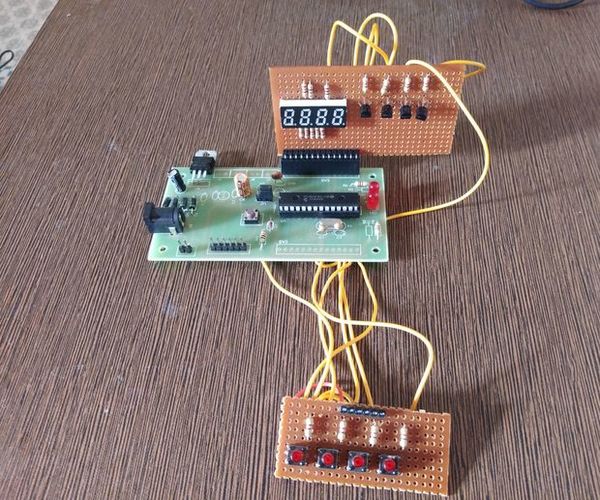
Programmable Cyclic Set On-Off Timer With Relay Output
"This project is to build cyclic on-off programmable timer. In this project user can set ON timer and Off time using keys and 7 segment display. Relay is provided as output, where relay will be remained ON for ON time and it will goes OFF after ON time overs. And Relay will remain Off till Off time overs. We Requires 4 keys for operation like Change digit, shift digit and start and stop timer. " [...]
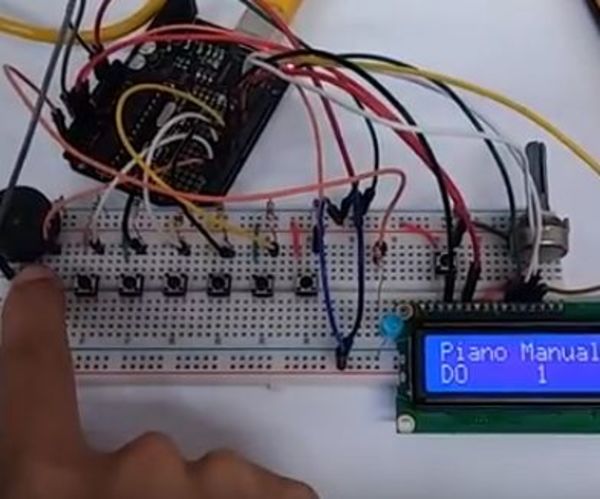
Manual Piano W/ Presets Songs Using Arduino
"Arduino Piano Keyboard interfacing with LCD has 2 mode. The Manual Mode & The presets mode. I used 7 Pushbutton for a simple 7 keys piano and 1 button for Setup Mode to switch to 7 presets songs. . Preset mode songs: Click the setup mode button first. super mario stage 1 super mario stage 2 fur elise despacito joy to the world jingle bells star wars" [...]
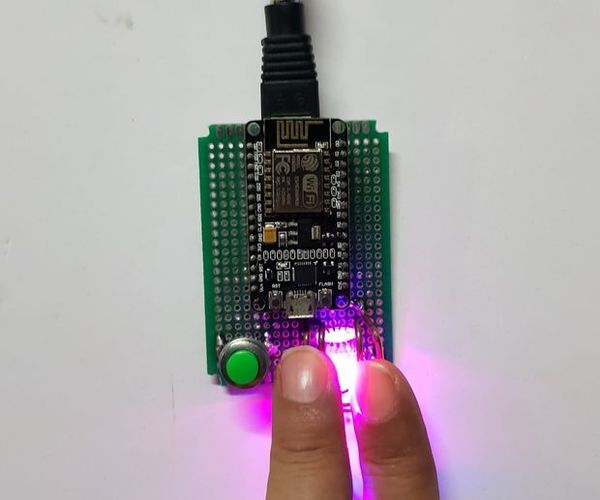
Wireless Illuminated Resistive Touch Button
"This is a simple project with idea of creating a resistive touch button that integrates RGB Led. Whenever this button is touched, it will be lighted up and lamps color can be customized. It can be used as a portable illuminated touch button through wireless network. " [...]

Arduino 3D Wire Bending Machine
"In this tutorial I will show you how I built an Arduino based 3D wire bending machine. This is actually a typical mechatronic system because it involves mechanical, electrical and computer engineering. So therefore I believe many engineering students or anyone who is new into mechatronics found this project interesting. " [...]

The URB Unit - Making Arduino's network
"Your personal universal electronics kit. More I/O pins. More devices. More distances. Remote wireless control. No bunch wires." [...]

Game of Life-Based Lighting
"Conway's Game of Life is a cellular automaton based zero player game. It can be used to create some brilliant lighting effects. Background A few weeks ago I showed a project I had created to monitor the temperature in my son's bedroom. Like many toddlers he is fascinated by lights and patterns of lights. This got me thinking to how I could create a interesting light effect for his bed room based of science and technology. After a little consideration I decided to implement the Game of Life created by Conway in 1970." [...]
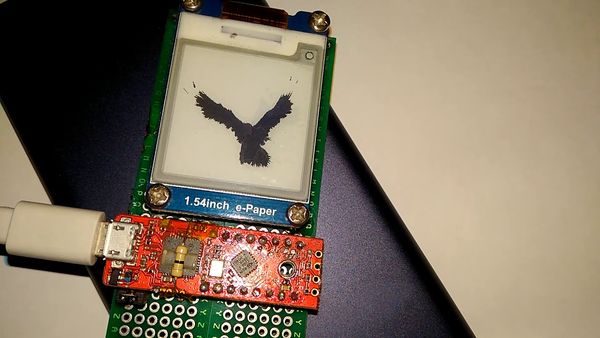
Animated E-Paper Badge
"An animated e-paper display badge for Hacksters. E-paper displays are fantastic for visual art but not fast enough for video or animation. Yet, I wanted to animate something in black and white canvas in slow motion. So, I made this badge! Hardware To build the hardware, two pieces of 2cmx8cm protoboards are glued side by side. Next, the XMC2Go board, LiPo battery, and 1.54-inch e-paper display are placed on the top of the protoboards." [...]
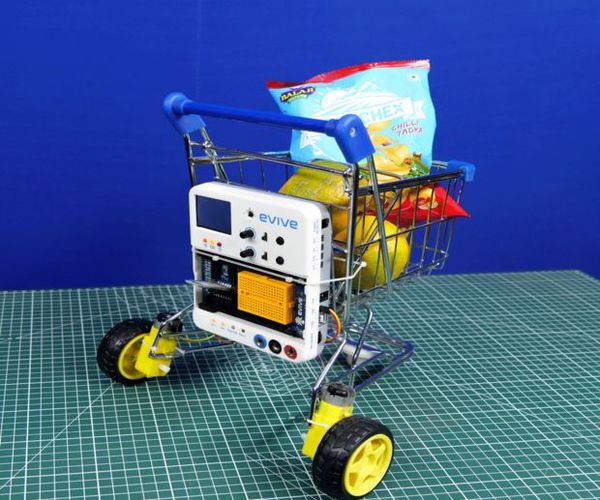
Smartphone Controlled Smart Shopping Cart
"Visiting malls can be fun. But dragging the Shopping Cart along as you fill it with stuff is something that is downright annoying. The pain of pushing it through those narrow aisles, making those sharp turns! So, heres (kind of) an offer that you cant refuse how bout transforming that regular, boring Shopping Cart into a cool DIY smart shopping cart that you can control with a few taps on your phone? Sounds like exactly what you need, right? Lets get started then!" [...]
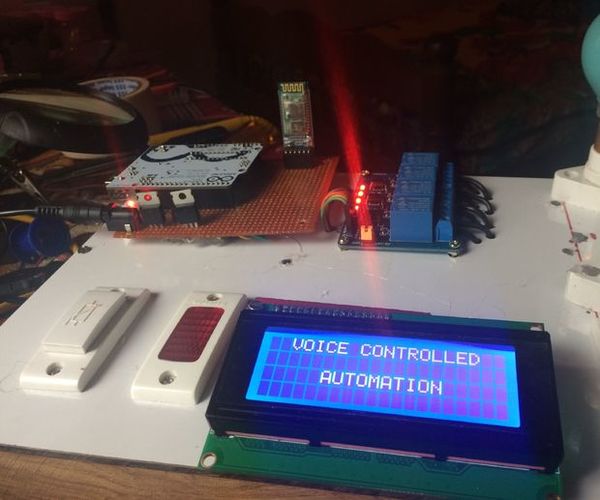
Voice Controlled Automation
"Nowadays, people have smartphones with them all the time. So it makes sense to use these to control home appliances. Presented here is a home automation system using a simple Android app, which you can use to control electrical appliances with clicks and voice command. Commands are sent via Bluetooth(HC05) to Arduino Uno, Which controls the relay operation( ON or OFF). So you need not get up to switch on or switch off the device while watching a movie or doing some work and other reasons. " [...]
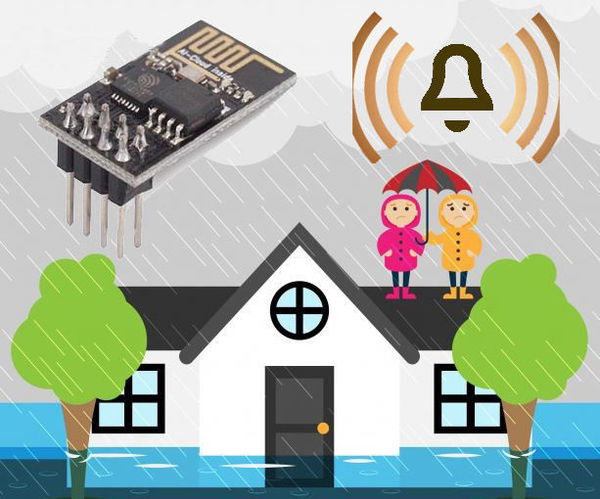
MQTT/Google Home Flood/Water WIFI Sensor With ESP-01
"In this instructable, I will show you how to build wifi flood/water sensor with minimal cost. The entire project costs me less than $8 for parts that I acquire from ebay and my existing spare-parts. In this project, we will use ESP-01 to provide Wifi and MQTT client to detect presence of water, and optionally use directly connected speaker/buzzer to provide localized alarm. My specific application for project is to detect flood/water inside my sump pump well, in the case of sump pump failure. When water is detected by 2 open wires, it would send message to MQTT broker. MQTT broker would then relays the message to NodeRED." [...]

Safety Device Used in Labs and Kitchen
"This is a safety device which is used in labs and in kitchen.This is an Arduino project which can save many lives. It has a gas sensor which can detect any smoke or gas leaks. An alcohol sensor which can detect the presence of any alcohol. It has a temperature sensor to detect high temperatures and a fire alarm to detect fire. I will be showing you a detailed tutorial on how to make it. " [...]

Dub Siren Synth - 555 Timers
"Dub Siren! Man – I didn’t even know that these existed until a DJ friend asked me to make him one. I had to do some digging (a lot of digging actually – there isn’t much on the net surprisingly) to find out the history of the dub siren and it didn’t disappoint. Seems that it originated in Jamaica in the late 60’s, early 70’s where they started to use sirens and analog synths to create sound effects for their music. Later it was emulated to live DJ performances using something similar to this ‘ible. So what is a dub siren?" [...]

Building the Overkill Control Box, by Ian Hillway
"I designed the Overkill Control Box to meet a specific need, to be able to control a spaceship in a video game with the ability to move forward, back, left and right, up, and down, plus a whole lot of buttons to control different functions on the ship. It started out very simple, but evolved into something much more robust than I expected. If you want to see the evolution of the Overkill Control Box, watch the attached video. Otherwise, feel free to skip ahead. " [...]
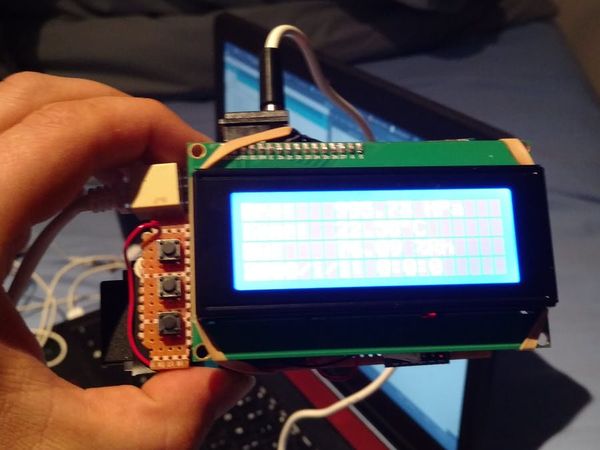
Simple Mini Logger
"A simple humidity, temperature, and pressure data logger. Components Arduino Pro Mini 5V 16MHz SD card module RTC module with battery RJ11 socket (optional) BMP180 pressure sensor (preferably with a 5V input power option on a breakout board) SHT31-D humidity sensor 24 X 4 LCD module with I2C interface 3 small push buttons Lots of little wires Soldering iron and also a usb to serial adaptor to program the arduino. Why I Made It I wanted to be able to view live atmospheric information and also log it for looking at it in a graph whenever I want. Simply I have not included a case in this project as I'm sure people will know what the best case for them selves is. I started by soldering all the components onto a strip board like so I thought we be most efficient. " [...]
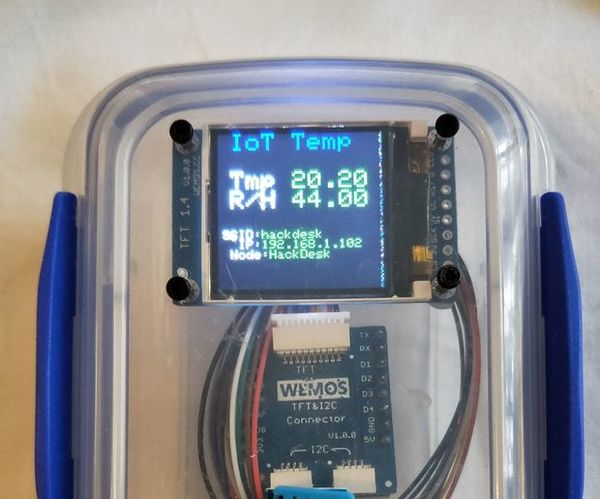
IOTTemp - WEMOS Based Cheap, Durable Temperature and Humidity Internet Logger With Display.
"I wanted to share a small project that I think you will like. It is a small, durable internet enabled temperature and humidity internet logger with display. This logs to emoncms.org and optionally, either locally to a Raspberry PI or your own emoncms server. It features the LOLIN (formerly WEMOS) D1 Mini which incorporates the ESP8266 core. Temperature and Humidity sensor is the LOLIN DHT 3.0 I2C sensor. The software is Arduino and naturally, open source." [...]
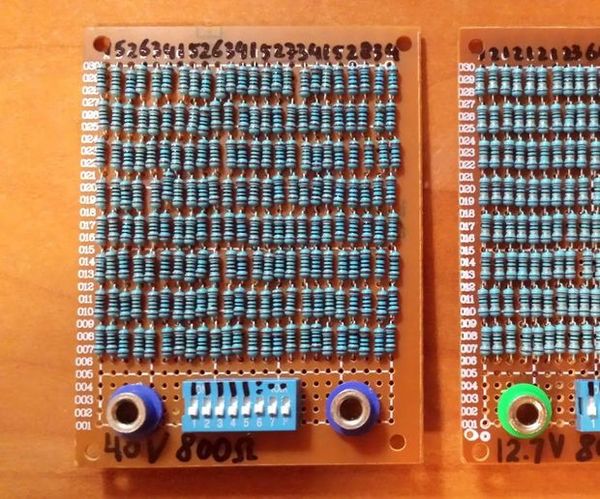
48W Resistive Load
"For projects with just a few LEDs, a small display or a buzzer, power is usually not a big issue and can easily be supplied by the Arduino pins itself or through a battery or small USB power supply. But for projects that involve larger motors, solenoids, high-power LEDs, Peltier elements, etc, the power management is often non-trivial and appropriate power supplies and switches (relays, MOSFETs, BJTs) become non-trivial parts of the design, often the most challenging! To test whether the project can handle the required current, it is often crucial to test it with a dummy load instead of the actual motor/lamp/relay. This allows in particular to stress-test the system by making it sure it can run with for example 400mA, when the actual motor only requires 300mA. Fancy dummy loads with constant current, constant power or constant resistance can be bought, but it's a niche market for professionals, and for a hobbyist a simpler system is often sufficient. The most common small-signal resistors used in circuits have a power rating of 0.25W, which is really not a lot." [...]

Pocket Metal Locator
"Cool little Pocket Metal Locator sensitive enough to identify small nails and tacks in wood with four independent search coils and LEDs. This cool little Pocket Metal Locator is sensitive enough to identify small nails and tacks in wood and compact enough to fit into awkward spaces making it convenient to carry and use for metal locating. The unit has four independent search coils and color LED indicators making it easy to cover a larger search area quickly while being able to accurately identify the target. This neat little device is self-calibrating with one button operation, rechargeable through a USB port and uses color LEDs, sound and vibration to indicate target strength. Included in the tutorial is all of the designs, testing, code and 3D files required to build on your own. I hope you enjoy building and using this as much as I have!!" [...]

Interactive Spooky Halloween Cat
"Check out this distance sensing Halloween prop designed to spook the willies out of trick-or-treaters. As we approach the end of October, the spooky Halloween energy is starting to find its way into my world. I’m not much of a Halloween-er myself, but I have always felt that Halloween is an excellent excuse to show off your killer maker skills, creativity and maybe even scare some folks. This week I made a little interactive Halloween decoration that activates when someone walks by. My Interactive Spooky Halloween Cat consists of a plastic skeleton cat I found at Michaels and an enclosure that I laser cut from black acrylic. Inside the enclosure is a SparkFun BlackBoard as the brains of the project, an Ultrasonic Sensor for distance sensing, a Qwiic MP3 Trigger Board to add some hissing sound effects, a small hamburger speaker for the sound, a small servo motor to create motion in the cat’s jaw, 16 WS2812 LEDs to create the red light and a small breadboard to make the circuit building quick and easy." [...]

Digital Photo Picture Frame, WiFi Linked Raspberry Pi
"This is a very easy and low cost route to a digital photo frame – with the advantage of adding /removing photos over WiFi via ‘click and drag’ using a (free) file transfer program. It can be powered by the tiny £4.50 Pi Zero. You can also transfer photos direct from a mobile phone (e.g. via ES File Explorer on Android). This can be a standalone digital picture frame or can be the screensaver for a Pi based system (doing something else) and show pictures when it is not being used. For example, this could be the screensaver for a Pi based media controller or for an interface to my Pi based music and radio player." [...]
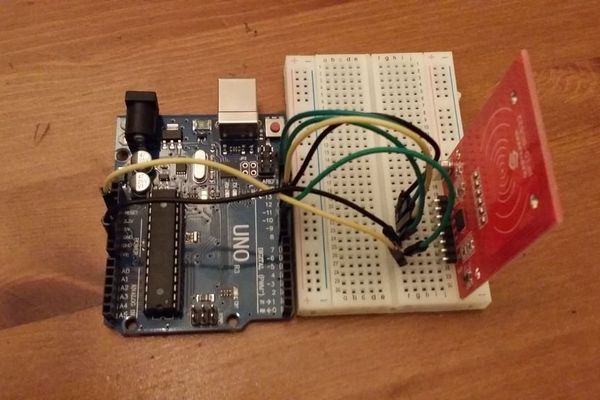
Use MFRC522 RFID Reader With Arduino
"Hello! I am going to teach you how to make a cool, easy to make key card or key fob scanner! If you have a RFID MFRC522 module, leds, resistors, wires, a arduino uno, a breadboard, and a 9v battery(optional), then you are good to go to make a cool, easy to make key card or key fob scanner! " [...]

Signal Generator AD9833
"A signal generator is a very useful piece of test gear. This one uses an AD9833 module and an Arduino Nano - that's all, not even a PCB. You can optionally add an OLED display. The AD9833 can gererate sine, triangle and square waves from 0.1 MHz to 12.5 MHz - the software in this project is limited to 1Hz to 100kHz. There have been other Instructables using an Arduino and an AD9833, here and here. This is simpler and can be used as a sweep generator." [...]
That's all Folks!


